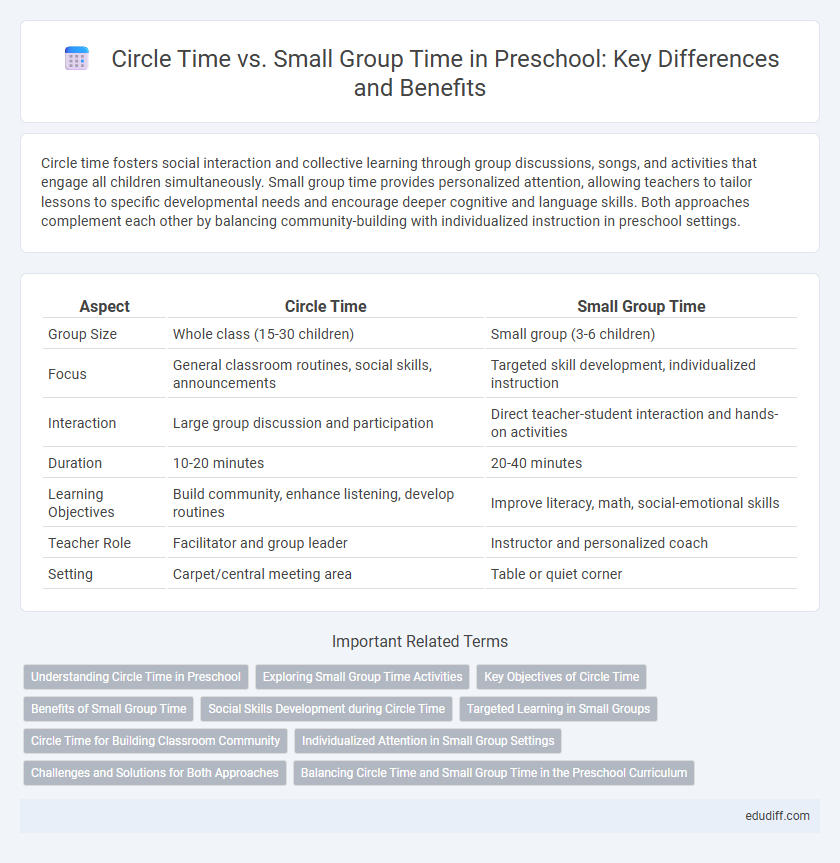Circle time fosters social interaction and collective learning through group discussions, songs, and activities that engage all children simultaneously. Small group time provides personalized attention, allowing teachers to tailor lessons to specific developmental needs and encourage deeper cognitive and language skills. Both approaches complement each other by balancing community-building with individualized instruction in preschool settings.
Table of Comparison
| Aspect | Circle Time | Small Group Time |
|---|---|---|
| Group Size | Whole class (15-30 children) | Small group (3-6 children) |
| Focus | General classroom routines, social skills, announcements | Targeted skill development, individualized instruction |
| Interaction | Large group discussion and participation | Direct teacher-student interaction and hands-on activities |
| Duration | 10-20 minutes | 20-40 minutes |
| Learning Objectives | Build community, enhance listening, develop routines | Improve literacy, math, social-emotional skills |
| Teacher Role | Facilitator and group leader | Instructor and personalized coach |
| Setting | Carpet/central meeting area | Table or quiet corner |
Understanding Circle Time in Preschool
Circle time in preschool is a structured group activity where children gather to engage in songs, stories, and discussions, fostering social skills and collective learning. Unlike small group time, which targets individualized or focused skill development, circle time emphasizes community building and shared experiences. This practice enhances language development, attention span, and cooperative behavior among preschoolers.
Exploring Small Group Time Activities
Small group time in preschool offers targeted opportunities for hands-on learning, social interaction, and individualized support, enhancing children's cognitive and language development more effectively than circle time. Activities during small group time include guided reading, sensory play, and problem-solving tasks that promote critical thinking and collaboration. These focused sessions allow educators to tailor instruction to diverse learning needs, fostering deeper engagement and skill mastery.
Key Objectives of Circle Time
Circle time in preschool emphasizes social-emotional development, language skills, and group participation by encouraging children to share ideas and listen to peers. Key objectives include fostering a sense of community, enhancing communication abilities, and introducing daily routines or topics through songs, stories, and discussions. Small group time, in contrast, targets individualized learning, allowing teachers to address specific developmental needs and tailor activities to support cognitive and fine motor skills.
Benefits of Small Group Time
Small group time in preschool offers targeted interaction that enhances personalized learning and social development. This setting allows educators to address individual children's needs, fostering language skills, critical thinking, and emotional regulation more effectively than larger circle time sessions. Small group activities promote collaboration and confidence, laying a strong foundation for academic success and positive peer relationships.
Social Skills Development during Circle Time
Circle time in preschool significantly enhances social skills development by encouraging all children to participate in shared activities, fostering turn-taking, listening, and verbal communication. This collective setting promotes empathy, cooperation, and group problem-solving, as children observe and engage with diverse peers. Small group time, while beneficial for targeted skill-building, lacks the dynamic social interaction that circle time provides for broad social competence growth.
Targeted Learning in Small Groups
Small group time in preschool provides targeted learning opportunities that allow educators to focus on individual children's developmental needs, fostering skills in literacy, math, and social-emotional growth. Unlike circle time, which engages the whole class in general activities, small groups enable personalized instruction and meaningful interactions that promote deeper understanding and skill mastery. This focused approach supports differentiated learning, helping each child progress at their own pace while enhancing collaboration and communication within a smaller peer group.
Circle Time for Building Classroom Community
Circle time is essential for building classroom community by fostering social skills, encouraging group participation, and promoting emotional connections among preschoolers. Unlike small group time, which targets specific skill development, circle time emphasizes collective engagement and inclusivity, creating a shared sense of belonging. This structured routine supports language development and enhances classroom cohesion, making it a cornerstone of effective preschool education.
Individualized Attention in Small Group Settings
Small group time in preschool offers individualized attention that supports each child's unique learning needs, enhancing developmental outcomes more effectively than circle time's broader group engagement. Teachers can tailor activities and interactions during small group sessions to address specific skills, interests, and challenges, fostering deeper understanding and personal growth. This focused approach promotes language development, social skills, and cognitive abilities by providing targeted support in a more intimate setting.
Challenges and Solutions for Both Approaches
Circle time often presents challenges such as limited individual attention and potential disengagement from shy or restless children, while small group time struggles with resource constraints and maintaining consistent engagement across varied developmental levels. Solutions for circle time include incorporating interactive activities and visual aids to enhance participation, whereas small group time benefits from targeted lesson plans and flexible groupings that address specific learning needs. Balancing these approaches requires adaptive scheduling and ongoing assessment to maximize social interaction and personalized instruction in preschool settings.
Balancing Circle Time and Small Group Time in the Preschool Curriculum
Balancing circle time and small group time in the preschool curriculum enhances social-emotional development and individualized learning. Circle time fosters group communication and classroom routines, while small group time allows targeted activities promoting cognitive skills and personalized attention. Effective scheduling integrates both methods to support diverse learning styles and maximize engagement.
Circle time vs Small group time Infographic

 edudiff.com
edudiff.com